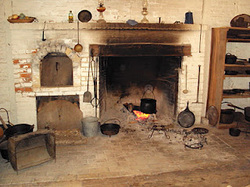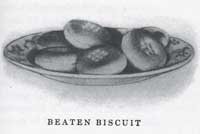Baking Without Thermometers or Electricity

A Dutch oven, while useful, couldn't bake everything the Colonists wanted or needed. Judging by the variety of recipes detailed by Amelia Simmons in American Cookery, Colonists baked many different types of cakes, pies and tarts. This was most often done in a wood-fired oven, built in a dome or beehive shape (see photo of oven next to the hearth in a Colonial kitchen at right). Early in the morning, the cook would stack the wood inside and light it, and allow the wood to burn down to embers. The ashes would then be swept away (some ovens were built with a trapdoor, where the ashes could be swept under the oven). To check the heat, "a cook would stick her arm up the chimney and into the oven. If she could count to ten, then the temperature was just right. Frequent bakers had no hair on their arms because it was singed off" (Ichord, 1998, p. 11).
Baking Basics
|
The bakers of today share many of the same methods with Colonial bakers, albeit with the use of automatic mixers and other modern conveniences. Ingredients were mixed together by hand. Dough was left to rise before baking. Bread, rolls and cookies were shaped or cut by hand (Kalman & Brown, 2002, p. 17). Cookbook instructions were not as detailed as they are today, in fact "old recipes were often vague. Directions may say 'don't scorch.' Or quantities may call for 'a bit.' Measures were done in weights and recipes were for large quantities, calling for as much as 20 eggs, three pounds of sugar, two pounds of butter and four pounds of flour" (Maron, 2010, para. 4). Baking was done in large quantities and then stored for eating by the family all week long.
Many of the early Colonists had religious beliefs that didn't permit working, including cooking, to be done on Sunday. Therefore baking was often "planned for Saturday night supper so that the leftovers could be kept in the oven and eaten warm for Sunday meals" (Ichord, 1998, p. 11). |
A walkthrough of Winkler's Bakery in Old Salem, NC. |
Rising To The Occasion

Yeast (the ingredient in bread that causes it to rise when baked) is readily available from the grocery store shelves today, but our American ancestors didn't have it quite so easy. "Colonial cooks skimmed yeast from the top of beer or ale, mixed it with flour, and then added water and salt to make bread dough" (Kalman & Brown, 2002, p. 17). "This yeast was called barm. It was mixed with flour and then covered with a linen cloth and blanket, kept warm overnight, and then added to the rest of the bread ingredients on baking day" (Ichord, 1998, p. 13).
There was no baking powder available to the settlers, so in order to make "light and airy" beaten biscuits, "the dough was placed on a chopping block or a tree stump and pounded with a hammer or the flat end of an ax. Southerners used to say three hundred whacks were enough, but for company no less than five hundred would do!" (Ichord, 1998, p. 25).
There was no baking powder available to the settlers, so in order to make "light and airy" beaten biscuits, "the dough was placed on a chopping block or a tree stump and pounded with a hammer or the flat end of an ax. Southerners used to say three hundred whacks were enough, but for company no less than five hundred would do!" (Ichord, 1998, p. 25).
Title photo: Sugar cakes cooling (at right) of the wood-fired baking oven at Winkler's Bakery at Old Salem in Winston-Salem, NC. Taken in March 2012 by Brooks Jones.
